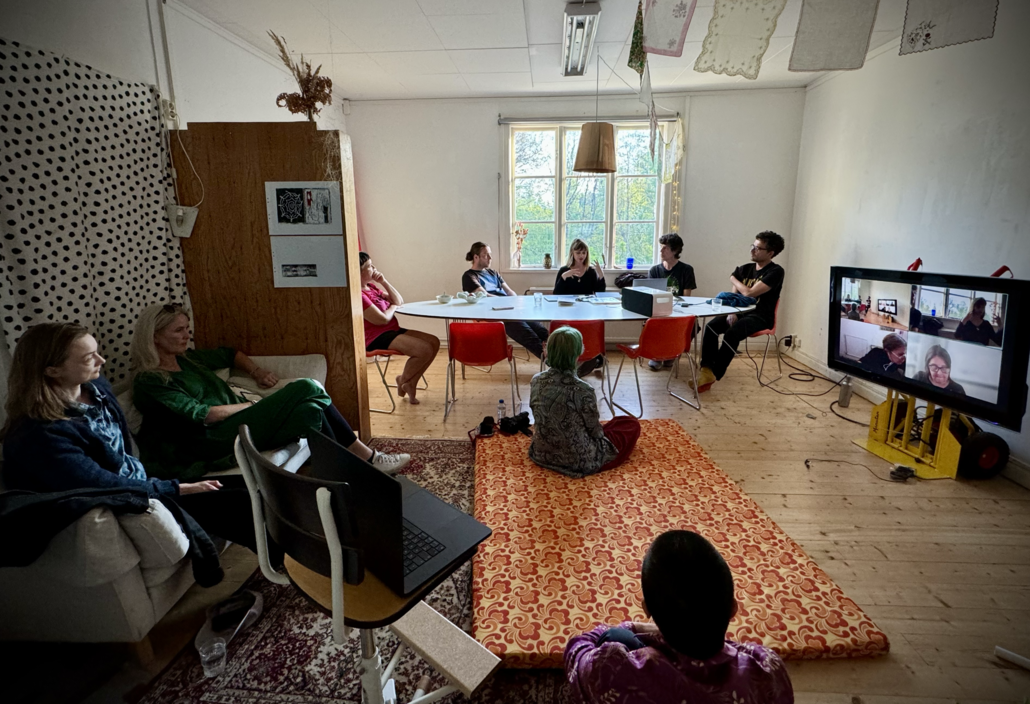Title: Unpacking 1
Date: May 25th, 2024
Moderator/presenter: John
Co-Presentors: Bernaditta and Cliff
Paricpating WAP artists
Vincent
Ming Ming
Shi Tou
Ami
Anna Viola
Invied guests:
Eva Larsson, artist (Stockholm/Björkö)
Kajsa Sandström, artist (Stockholm/Björkö)
Lena Gemzöe (video link)
Rebekah Dean (video link)
John opend up with all doing a short self presentation in relation to walking and art.
The questions were put primarily to Bernadita and Cliff as well as a reflection from John himself.
John's Reflections: Listening to Cliff and Bernadita I was reminded of what happens in my mind when I'm walking alone in a walking project. The stray things on my mind quiet down, the idea of the walk (the concept or inquiry) comes into focus, I am more attuned to my surroundings and observational, and I'm often able to formulate probing questions or responses. Cliff's long walk across the U.K. and Bernadita's short walk in the water represented for me the simple beauty of walking endeavors. I thought about the notion, 'if you really want to know, you'll just have to go out there'. This was a quote I'd seen attributed to Melville's Moby Dick, but I read the whole book and never found it... so maybe it's just made up, but I think it holds a kind of truth.
QUESTION 2
How do you describe your walking-based artwork for non-artists? Can you give one or 2 examples of your walking art?
Cliff - Question 2
Because my outcomes and approaches vary, I tend to try and connect to non-artists, and artists for that matter, on a thematic level. I approach explanations through the things that I am interested in and interested in exploring through my walking walk. Because I am interested in my subjective experience of the world, these are very human themes. What it means to grow up poor and how this affects your experience of place and the world. Similarly, what it means to grow up as a migrant, part of two identities but not wholly of either. What this 'context of origin' means when walking in the city, and how is that different to walking in rural areas. What it means to be disabled and a walker. How walking can help with issues of mental ill-health. These are some of my key areas of interest and research and I find most people can relate if not to them directly, then to my interest in them.
Cliff - Question 1
It varies and I haven't come to a concrete answer yet, but perhaps at the moment in 3 main ways. First, there are projects where the outcome is not walking but walking is visibly present in the work. I think of my project 'Saudade' where I walked across the island of my parents' birth hoping to get to know them better. The walking was key to the process of making the work and I talk about it in the work, but the outcome is a landscape photography project. Then there is work where the walking is not visibly present at all. I think of my current project 'No Place Like Home' about outer districts of London. I explored these outer districts on foot for years. And I did so deliberately. The way you experience a place on foot, the things you see you would otherwise miss, is essential for me. But the outcome of the project is a landscape photography photobook. You wouldn't know there was walking in there at all. And lastly there is the work where the walking is the work. I think here of my walk across the UK. As I migrant I wanted to know what it was to walk across this nation. How it would feel. Would I find some kind of peace with it through walking. So here the walking was everything.
Cliff
Rebecca Solnit quote:
Cliff- Question 3
I think I've pretty much answered this in Question 2. However, I mght simplify it in the following way. When walking, I am interested in why my mind seems to work in a different way than when I am not. And I am interested in 'place' and how certain places impact this working of my mind. How certain places provoke certain thoughts. And, for me, these thoughts are often memories. So I am interested in the phenomenon of memory. Walking, place and memory. And if you walk for long enough, I find I move to a place beyond thought. I am interested in this and am curious as to its therapeutic potential. The question for me then becomes how do I then take all this and produce it into a visual outcome? I find that the majority of 'walking art' is approached from a performance art angle. It makes sense. But that is not my background at all. So a lot of time I am thinking how do I articulate my experience of walking through a combination of drawing, photography, printmaking and moving image? And what do I need to gather on my walks (photos? drawings? notes? sounds? objects?) to enable me to do this.

